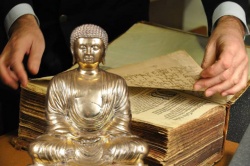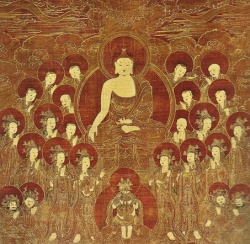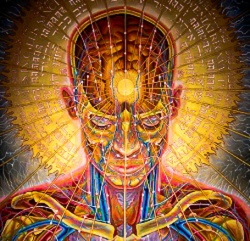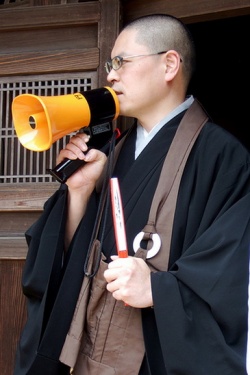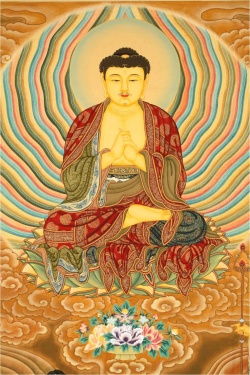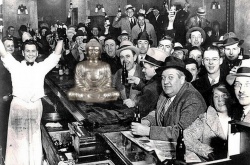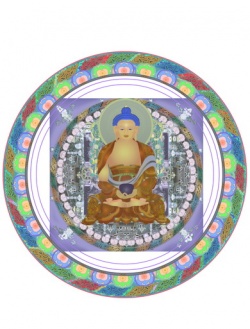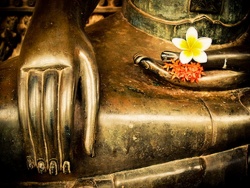A Critique of the Abhidhamma and Visuddhimagga
By Jhanananda
The term Abhidhamma is a compound Pali term of (Abhi + dhamma), which means "Higher Doctrine" or knowledge. The term implies a doctrine that leads to higher knowledge. The prefix 'Abhi' means to overcomes, conqueror or master; and implies spiritual mastery as well as the attainment of occult powers.
It is related to the following Pali terms: abhibhavati - (Abhi + bhå) overcomes; abhibhå - m. 'conqueror', 'master'; abhibháyatana: the 8 'stages of mastery' (occult powers); abhigacchati - (abhi + gamu) goes near to; abhijánáti - (abhi + -ñá) perceives; abhikkamati - (abhi + kamu) goes forward; Abhimaïgala - n. great festival; abhimukha - facing towards; abhinibbatti: a Sutta term for rebirth; s. punabbhava; abhiññá: The 6 'higher powers', or supernatural knowledge's.
Even though the Abhidhamma is considered to be the third major collection in the "three baskets" (Tipitaka) of Buddhist literature, which is common to all branches of Buddhism, it nonetheless was not a part of the Buddhist canon of literature until the third "Great Council" which was held at Paµaliputta around 247 BCE under the patronage of King Asoka.
The Abhidhamma is commonly attributed to the Buddha or to one of his best known disciples, Sariputta, since it arrived into the Buddhist canon well after the Buddha's death its attribution is clearly in error and is thus apocryphal. We can easily support that claim because the Buddha outlived Sariputta and there is no reference in the Discourses of the Buddha (Sutta Pitaka) to the Abhidhamma or to Sariputta composing a volume of literature.
I have not read any volume of the Abhidhamma, however, I frequently encounter references to it in the body of Theravadan and Vajrayana literature. Theravadans typically use it to support their stoic point of view and Tibetan Buddhists frequently refer to the Abhidhamma in their mysterious and ritual laden interpretation of Buddhism, neither of which, in my view, reflects an informed view of the Buddha's discourse.
The Abhidhamma appears to function as an early Buddhist commentary. It however, relies heavily upon rationalist logic and mysterious language that asserts a belief in the Buddha having a divine or supernatural (lokuttara) origin. This basic premise is in conflict with the Buddha's story as revealed in the Discourses of the Buddha, which portray him as someone who was not born divine, but who eventually took upon himself the contemplative life, and lived it successfully to arrive at enlightenment. Thus I have taken little interest in the Abhidhamma. There is no translation available of the Abhidhamma, so it is a mute point at this time.
When I first began to study the Sutta Pitaka I began that study because I found in the 30 years of my contemplative life there were many beliefs being passed off as the Buddha's teaching and I wanted to know what the Buddha really taught. I figured by studying the earliest Buddhist literature, which is arguably found in the Discourses of the Buddha (Sutta Pitaka), I could find out what the Buddha really said.
At that time I was in contact with Bhante Gunaratana who suggested a reading list for me, and he suggested that I first read the Visuddhimagga, because it would help me to understand the Sutta Pitaka. After making a close study of the Visuddhimagga I came away with the feeling that the original author, Buddhaghosa, had done everything he could to make the dhamma opaque, not transparent. In the Visuddhimagga I found there were more references to the Abhidhamma than there were to the Sutta Pitaka. Arguably that difficulty may have had to do with the translator, who was Bhikkhu Bodhi.
When I began to read the Sutta Pitaka I found it hardly needed commentary. However, I found most of the notes and commentaries in the translations seemed to fall well off the mark. Not coincidentally those notes frequently referred to the Visuddhimagga and the Abhidhamma. Those translations were primarily the Wisdom Publications collection by Walshe, and Bodhi.
After spending about 2 years conducting a close reading of the Sutta Pitaka and examining other translations of that collection I developed a deep suspicion that there was a hefty amount of translator bias at work in those translations. Halfway through a 3-year retreat I spent last winter in the Asian collection at the University of Arizona where I examined the four published Pali to English Dictionaries (Buddhadatta, Childers, Nyanatiloka, Rhys Davids). I also examined 23 published translations of the Dhammapada. After conducting a simple literary analysis of those dictionaries and translations of the Dhammapada I confirmed my suspicions and wrote an article called Exposing Translator Bias in the translation of Buddhist Literature
At the heart of my feelings that the Dhamma has been subjected to severe translator bias is the way in which the Sanskrit term "samadhi" is typically translated as "concentration." After more than 30 years of daily meditation practice I have found the attainment of samadhi is not at all described by the English term "concentration" but by another English term "ecstasy." Not coincidentally many of the Christian mystics, such as Teresa of Avila and John of the Cross, used the term "ecstasy" when describing their religious experiences. Considering that the Buddha defined the Sanskrit term "samadhi" in terms of bliss (piiti) and joy (sukha) I believe we can indeed conclude translating the term "samadhi" as "concentration" is like using the term "car" to describe a Ferrari. Yes samadhi is a state of concentration, however, there is a lot more going on in that state than concentration.
Two other concepts that commonly appear in commentaries and translations of the Buddha's discourses are the concept of "access concentration" (upacara-samadhi) and insight (vipassana). While many commentaries and translations of the Buddha's Discourses claim the Buddha taught two practice paths, one called "shamata" and the other called "vipassana," there is in fact no place in the suttas where one can definitively claim that. The idea of "access concentration" is also absent from the Buddha's discourse. I believe it originates in the Abhidhamma.
On this subject Dr. K. Jamanadas, a scholar of Asian literature, wrote a most interesting article called "ORIGINAL BUDDHISM AND BRAHMINIC INTERFERENCE."
At the heart of this article he claimed Brahmanism had subverted Buddhism, and he felt the Abhidhamma was at the heart of that subversion. While I am sure there is plenty of evidence of Vedic concepts within Buddhism we have to admit that Sidharta Gotama was a yogi, not a Buddhist, and as such he emerged from within the Vedic tradition, therefore there are going to be many Vedic concepts within Buddhism. Buddha, Dhamma and Sangha are, after all, certainly examples of Vedic concepts within Buddhism.
I recently came across a sutta in which it is revealed that the early monks were actually studying the Vedas. While this sutta maybe an example of tampering, I do not believe it is unreasonable to believe the early Buddhist monks may have indeed studied the Vedas as a foundation for their study of the Buddha dhamma.
If we look at Tibetan Buddhism we will find the most obvious example of Hindu-izing of Buddhism with their adherence upon ritualized forms, deity worship and guru worship. However, is Hindu-izing or Brahman-izing Buddhism that bad? I do not think so. I believe what is behind the concern for Hindu-izing Buddhism is a bit of xenophobia.
In his first paragraph Dr. K. Jamanadas brings up misogynous additions to the Sutta Pitaka. While I agree there are some pretty blatant misogynous references in the Sutta Pitaka and they are doubtlessly additions after the Buddha (after all the Buddha is quoted throughout saying he had enlightened woman in his community), however, we can hardly blame Hindus or Brahmans for the misogyny. Misogynism is part of Asian culture. After all if Theravadans were not misogynists they would have restored ordination for the nuns 1500 years ago, soon after female monasticism was destroyed by invading men, who were offended by women taking up monasticism. Instead the Theravadans have been fighting the ordination of women to this day.
I will, however, agree with Dr. K. Jamanadas when he says the "preaching of equality among the masses was (perceived as) detrimental to the hegemony the Brahmins." In fact I believe what was at the root of Siddhartha Gotama's teaching strategy was providing a venue for enlightenment to be recognized among the laity as well as women and the peasantry.
I particularly enjoyed reading about "the First Sangiti (council) at Rajgriha convened soon after the parinirvana of the Buddha in 483 BCE...It should be noted that Chulla Vagga mentions the compilation of Dhamma and Vinaya only there being no mention of Abhiddhamma." This means the Abhiddhamma is apocryphal and cannot thus be relied upon as a primary source for understanding the dhamma. This is particularly important to a jhana informed discourse because there are aspects of commentary that do not correspond to the experience of jhana, and it should be noted these commentaries site the Abhidhamma as their source. The particular issue that refers to Abhidhamma is the concept of "access" concentration (upacara-samadhi), which this contemplative wholly rejects as an attempt to obfuscate and distance the jhana experience.
Dr. K. Jamanadas's section on the Second Council makes much to do about Sanskrit being adopted as a liturgical language for Buddhism. However, he does not point out the loss to the jhana discourse, as a product of that conversion to Sanskrit, In the translation of the Tipitaka to Sanskrit, the Pali term 'jhana' was translated as 'dhyana.' This error converts the attainment of meditative absorption, as represented by the Pali term 'jhana' into the mere practice of meditation techniques, which is what the Sanskrit term 'dhyana' means.
In the section of his article covering the second council Dr. K. Jamanadas writes, "After they split, they not only changed the 'Vinaya'... but they also changed the 'Dhamma' and laid down new Dhamma contrary to (the) established one...(in which they) declared Buddha as 'lokottara' - superhuman, having no worldly attributes... (and) changed the summum bonum from Arhanthood to Buddhahood. Thus degrading the arhants" to a lower status and we should note this change would thus make it further possible to reject or distance the jhanic experience by making it beyond the human experience.
Under the section on "Asoka Times" I found the whole section interesting, because Jamanadas examines the books of the Pitaka and even the sutta pitaka and tells us which books came later into the Pitaka much after Siddhartha Gotama's parinibbana:
"The Buddha had said your guru in future will be 'Dhamma' and 'Vinaya', and so I did not appoint the successor. Why should it then be called 'Three Pitakas'? It was Mogaliputta Tissa who introduced the nomenclature of Pitakas as Vinaya, Sutta, and Abhidhamma and introduced ordinary book like "Chariya Pitaka", which was given prestige of Pitaka, as if it was original word of the Buddha. Incarnation and Rebirth was introduced here in Chariya Pitaka. Majjhim Nikaya - Chul Dukkh Khanda Sutta clearly mentions that the Buddha had said that there is only One birth and that is the present one. Due to Chariyapitaka, with 34 short stories turned into verse, the technical Jatakas were later thought of by the Attakathakaras. Paramitas were added for each birth.
Abhidhamma was tried to be mixed with Khuddak Nikaya. But there is difference of opinion among Bhikkus from Sri Lanka, Myanmar and Thailand about Khudak Nikaya. Only agreed books are five, namely -- Khuddak paath, Udaan, Itivuttukh, Sutta Nipat andDahammapad. Thus it is clear and can be proved that Sutta Pitaka had been tampered with by the Brahmin Bhikkus. Barring Khuddak- Paath the remaining four are available in Chinese translations. All others are not considered original 'Buddha Vachana'."
In his section titled *The last phases* he says Buddhaghosa actually burned the original manuscript for the A.t.thakathaa of Mahinda.
"He (Buddhaghosha) goes to Sri Lanka, proves his ability by writing 'Vissuddhimagga', and undertakes the work of writing Attakathas, the work which was started by Buddhadatta and left unfinished. The Attakathas which were translated into Sinhalese by Mahinda are retranslated into Pali. So far so good. But then he burns the old Attakathas of Mahinda and leaves no trace of verifying the correctness of his translations. The surprising part is that Sri Lankans allow him to do that. As is well known these Attakathas are full of miracles and superhuman ideas, not in consonance with the original ideas of the Buddha."
While many commentaries and translations of the Buddha's Discourses claim the Buddha taught two practice paths, one called "shamata" and the other called "vipassana," there is in fact no place in the suttas where one can definitively claim that. The idea of "access concentration" (upacara-samadhi) is also absent from the Buddha's discourse. I believe we can thus conclude that the Abhidhamma and the Visuddhimagga are classic cases of appropriation, subversion and obfuscation of the Buddha dhamma, so I do not recommend them for study for anyone who wants to understand what the Buddha taught.
May you be enlightened in this very lifetime,
Jhanananda (Jeffrey S. Brooks):
This document can be retrieved at this URL:
http://www.greatwesternvehicle.org/criticism/abhidhamma.htm
Sources:
All definitions are from A Contemplative's Pali-English, English-Pali Dictionary, GWV, Tucson, AZ USA, 2005
Dr. K. Jamanadas "ORIGINAL BUDDHISM AND BRAHMINIC INTERFERENCE"
Exposing translator bias in the translation of the Pali Canon and other Asian literature (updated 11-10-04)
Digha Nikaya, DN (The Long Discourses).
translation by Maurice Walshe.
Wisdom/Buddhist Publication Society BPS. 1996:
Majjhima Nikaya, MN (The Middle Length Discourses).
translation by Bhikkhu Nanamoli.
Ed. Bhikkhu Bodhi. Wisdom/Buddhist Publication Society BPS
Samyutta Nikaya, SN (The Connected Discourses of the Buddha)
translation by Bhikkhu Bodhi.
Wisdom Publications. Or ATI
Buddhadatta, A.P. (Ambalangoda Polvatte, (1887-1962), Dhammapadam: an anthology of sayings of the Buddha, The Colombo Apothecaries Co, Ltd, Colombo, Ceylon,
Childers, Robert Caesar, 1838-1876, A Dictionary of the Pali language, Rinsen Book Co., 1976, Kyoto, reprint of 1875 ed. Trubner, London
Nyanatiloka edited by Nyanaponika, "Buddhist Dictionary," third revision, Buddhist Meditation Centre, Singapore. 1991
Rhys Davids, T.W., FBA, D. Sc., Ph.D.,L.L.D., D. Litt. And William Stede, Ph.D. editors, The Pali Text Society's Pali-English Dictionary, Published by the Pali Text Society', By Luzac & Company 1966, London
